NCERT Solutions For Class 10 Science Chapter 8 How Do Organisms Reproduce? : In this article we will provide you detailed information regarding NCERT Solutions For Class 10 Science Chapter 8 How Do Organisms Reproduce?. Working on how do organisms reproduce class 10 NCERT Solutions will help candidates to score good marks in the subject Science. Further working on NCERT Solutions For Class 10 Science will help candidates to crack the Medicine competitive exams.
With the help of how do organisms reproduce class 10 important questions with answers students will score good marks in board exams as well. Read on to find out everything about NCERT Solutions For Class 10 Science Chapter 8 How Do Organisms Reproduce?.
NCERT Solutions for Class 10 Science Chapter 8 How Do Organisms Reproduce?
Before getting into the details of how do organisms reproduce class 10 extra questions and answers, let’s have an overview of topics and subtopics under NCERT Solutions For Class 10 Science Chapter 8 How Do Organisms Reproduce?:
- How Do Organisms Reproduce?
- Do Organisms Create Exact Copies Of Themselves?
- Modes Of Reproduction Used By Single Organisms
- Sexual Reproduction
Free download NCERT Solutions for Class 10 Science Chapter 8 How Do Organisms Reproduce PDF in Hindi Medium as well as in English Medium for CBSE, Uttarakhand, Bihar, MP Board, Gujarat Board, and UP Board students, who are using NCERT Books based on updated CBSE Syllabus for the session 2019-20.
- जीव जनन कैसे करते है कक्षा 10 विज्ञान हिंदी में
- Class 10 How do Organisms Reproduce Important Questions
- How do Organisms Reproduce Class 10 Notes
- How do Organisms Reproduce NCERT Exemplar Solutions
- How do Organisms Reproduce? Class 10 Extra Questions
- Class 10 How do Organisms Reproduce Mind Map
NCERT Solutions for Class 10 Science Chapter 8 Intext Questions
Page Number: 128
Question 1
What is the importance of DNA copying in reproduction?
Answer:
DNA copying has following importance in reproduction:
- It maintains the characteristics of species.
- It maintains the continuity of life.
- From this, the characteristics and features of organisms are transformed to their progeny.
- It produces variations in organisms which is the basis of evolution of new species.
Question 2
Why is variation beneficial to the species but not necessarily for the individual?
Answer:
The various populations of organisms interact with many types of ecological niches. This is important for them to survive in given conditions. In case of any damage caused to the ecological conditions of the population, the population gets adversely affected. The organisms which are able to survive, may reproduce to develop population which is adapted or suited to the varied conditions. Hence variation is beneficial to species, but not to the individuals.
Page Number: 133
Question 1
How is the process of pollination different from fertilisation ?
Answer:
| Binary fission | Multiple fission |
| 1. In this an organism divides into two similar organisms. | 1. In this an organism produces two or more organisms. |
| 2. A cyst or thick layer is not formed around the cell. | 2. A cyst or thick layer is formed around the cell. |
|
It generally occurs in favourable conditions
Example : Amoeba, paramecium |
3. It can take place in unfavourable conditions too.
Example: Malarial parasite. |
Question 2
How will an organism be benefited if it reproduces through spores ?
Answer:
An organism is benefited by reproducing through the spores because spores are surrounded by a thick layer which protects them in adverse conditions. When the favourable conditions occur, these spores start to grow again. In this way they are successfully live in unfavourable conditions.
Question 3
Can you think of reasons why more complex organisms cannot give rise to new individuals through regeneration ?
Answer:
In complex multicellular organisms, specialised cells make up tissues, tissue make up organs, organs make up organ systems and finally organ systems make up organisms. Since complex multicellular organisms have a very high degree of organisation in their body, they cannot be reproduced from their cut body parts by the process of regeneration.
For example, a dog is a complex multicellular organism which cannot be regenerated from its cut body part say, a cut tail. This is because the cells present in the cut tail of a dog cannot produce dog’s organs like heart brain, lungs, stomach, intestines and limbs, etc, needed for the making of a complete dog.
Question 4
Why is vegetative propagation practised for growing some types of plants ?
Answer:
Vegetative propagation is practiced for growing such plants which usually do not produce seeds or produce non-viable seeds.
Question 5
Why is DNA copying an essential part of the process of reproduction ?
Answer:
DNA copying is essential part of the process of reproduction so that the characteristics of the parent organisms are transmitted to its offspring and at the same time some occasional variations are also produced in the offspring. The changes in the copy of DNA provide an organism the capability to survive in changing conditions.
Page Number: 140
Question 1
How is the process of pollination different from fertilisation ?
Answer:
| Pollination | Fertilisation |
| 1. The transfer of pollen grains from the anther of a stamen to the stigma of a carpel is called pollination. | 1. Fertilisation occurs when the male gamete present in pollen grain joins with the female gamete (or egg) present in ovule. |
| 2. It takes place by various pollinating agents. | 2. It takes place by natural or artificial means. |
Question 2
What is the role of the seminal vesicles and the prostate gland ?
Answer:
(i) Both seminal vesicle and prostate gland secretes fluids which forms a part of the semen. The fluid secreted from seminal vesicle forms 60% of semen while the fluid secreted from the prostate gland forms 30% of the semen. It makes the path smooth through which the sperms travel.
(ii) This fluid protects the sperms from the acids present in the urethra.
(iii) This fluid provides nutrition to sperms in the form of fructose, calcium and some enzymes.
Question 3
What are the changes seen in girls at the time of puberty ?
Answer:
The various changes occur in girls at puberty are :
- Hair grow under armpits and pubic region.
- Mammary glands (or breasts) develop and enlarge.
- The hips broaden.
- Extra fat is deposited in various parts of the body like hips and thighs.
- Fallopian tube, uterus and vagina enlarge.
- Ovaries start to release eggs.
- Menstruation (monthly periods) starts.
- Feelings and sexual drives associated with adulthood begin to develop.
Question 4
How does the embryo get nourishment inside the mother’s body ?
Answer:
In mother’s body, the embryo gets nutrition from the mother’s blood. For this, there is a special structure, called placenta. Placenta contains villi. There are empty spaces in mother’s tissues that cover the villi. It provides a large surface area for the transfer of glucose, oxygen and other substances from the mother to the embryo.
Question 5
A woman is using a copper-T. Will it help in protecting her from sexually transmitted diseases ?
Answer:
Copper-T is a contraceptive method which prevents implantation of the zygote inside the uterus. It cannot prevent a women from sexually transmitted diseases. These diseases are transmitted by contact which cannot be prevented by copper-T.
NCERT Solutions for Class 10 Science Chapter 8 Textbook Chapter End Questions
Question 1
Asexual reproduction takes place through budding in
(a) amoeba
(b) yeast
(c) plasmodium
(d) leishmania
Answer:
(b) Yeast
Question 2
Which of the following is not a part of the female reproductive system in human beings ?
(a) Ovary
(b) Uterus
(c) Vas deferens
(d) Fallopian tube
Answer:
(c) Vas deferens
Question 3
The anther contains
(a) sepals
(b) ovules
(c) carpel
(d) pollen grains
Answer:
(d) Pollen grains
Question 4
What are the advantages of sexual reproduction over asexual reproduction ?
Answer:
(i) In asexual reproduction, the offspring are almost identical to their parent because they have the same genes as their parent. So, much genetic variation is not possible in asexual reproduction. This is a disadvantage because it inhibits the further evolution of the organism.
(ii) In sexual reproduction the offspring, although similar to their parents, are not identical to them or to one another. This is because the offspring receive some genes from the mother and some from the father. Because of the mixing of genes of mother and father in various different combinations, all of the offspring have genetic variations. In this way, sexual reproduction leads to a greater variety in population. This means that a species (animal or plant) can adapt quickly to changes in its surroundings. This is because there are always likely to be some individuals which are more suited to the changes than others, and these individuals will survive and reproduce themselves.
Question 5
What are the functions performed by the testis in human beings ?
Answer:
The functions of testes in humans are following :
(i) After the stage of adolescent, testes produce male gametes in the human males which are called sperms.
(ii) A hormone called testosterone is produced in testes. Testosterone controls the development of reproductive organs and secondary sexual characters.
Question 6
Why does menstruation occur ?
Answer:
If the ovum (or egg) does not get fertilised (due to non-availability of sperm in the female body) then the thick and soft inner lining of uterus is no longer needed and hence it breaks. So, the thick and soft inner lining of uterus alongwith the blood vessels and the dead ovum (or egg) comes out of the vagina in the form of blood called menstruation. Menstruation occurs after the interval of every 28 days and the time period between ovulation and menstruation is about 14 days.
Question 7
Draw a labelled diagram of the longitudinal section of a flower.
Answer:
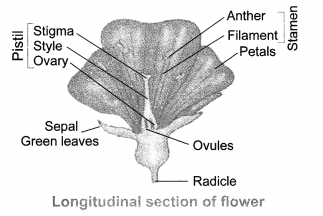
Question 8
What are the different methods of contraception ?
Answer:
The different methods of contraception are as follow :
(i) Barrier method :
In this method, condom, diaphragm and cervical caps are used. These prevent the entry of sperms in the female genital tract during sexual intercourse.
(ii) Chemical method :
In this method a woman uses two kinds of pills (oral and vaginal pills). The oral pills are hormonal preparations which suppress the release of ovum in fallopian tube. These are called oral contraceptives. The vaginal pills/ creams are spermicidal. The chemicals in these spermicidals kill the sperms during their journey in the vaginal tract.
(iii) Intrauterine contraceptive devices :
Intrauterine contraceptive devices such as copper-T are placed safely in the uterus by a skilled doctor. It prevents the sperms to reach the uterus.
(iv) Surgical method :
In this method, a small part of vas deferens of male and fallopian tube of female is cut or tied by surgery. It is called vasectomy in males and tubectomy in females.
Question 9
How are the modes for reproduction different in unicellular and multicellular organisms ?
Answer:
| Reproduction mode in unicellular organisms | Reproduction mode in multicellular organisms |
| (i) A sexual reproduction takes place in unicellular organisms. | (i) Sexual reproduction takes place in multicellular organisms. |
| (ii) Only one organism is required in this method. | (ii) A male and a female both are required in this method. |
| (iii) No special cells are present for reproduction. | (iii) Special cells are present for reproduction. |
| (iv) No special organs are present for reproduction. | (iv) Special organs are present for reproduction located at the fixed position in the body. |
Question 10
How does reproduction help in providing stability to populations of species ?
Answer:
The introduction of variations during reproduction provides stability to the populations of various species by preventing them from getting wiped out during adverse conditions. Reproduction also helps to generate copies of individuals which are suited to a particular environment.
Question 11
What could be the reasons for adopting contraceptive methods ?
Answer:
The reasons for adopting contraceptive devices are as follow:
- To control the birth rate and prevent the increase in population.
- To reduce the adverse effects on mother’s body due to frequent pregnancy.
- To provide safety from sexually transmitted diseases.
NCERT Solutions for Class 10 Science Chapter 8 How Do Organisms Reproduce?
Reproduction: Reproduction in animals and plants (asexual) and (sexual) reproductive health – need and methods of family planning. Safe sex vs HIV/ AIDS. Child bearing and women’s health.
| Board | CBSE |
| Textbook | NCERT |
| Class | Class 10 |
| Subject | Science |
| Chapter | Chapter 8 |
| Chapter Name | How Do Organisms Reproduce? |
| Number of Questions Solved | 26 |
| Category | NCERT Solutions |
Formulae Handbook for Class 10 Maths and Science
Page 128
Question 1.
What is the importance of DNA copying in reproduction?
Answer:
DNA copying in reproduction is important for maintenance of body designs and features. Moreover, DNA copying leads to variations. Variation is useful for the survival of species.
Question 2.
Why is variation beneficial to the species but not necessarily for the individual?
Answer:
Population of organisms reside in well-defined places or niches in the ecosystem. However, niches can change because of reasons beyond the control of the organisms, e.g., temperature changes, water level changes, etc. If population of reproducing organisms suited to particular niche and if the niche is drastically altered, the population can be wiped out. However, if some variations are present in a few inAividuals in these populations, there will be chances for their survival. The surviving individual can further reproduce and develop a population according to the changed niche, Thus, variation is beneficial to the species but not necessarily for the individual.
More Resources for CBSE Class 10
- NCERT Solutions
- NCERT Solutions for Class 10 Science
- NCERT Solutions for Class 10 Maths
- NCERT Solutions for Class 10 Social
- NCERT Solutions for Class 10 English
- NCERT Solutions for Class 10 Hindi
- NCERT Solutions for Class 10 Sanskrit
- NCERT Solutions for Class 10 Foundation of IT
- RD Sharma Class 10 Solutions
Page 133:
Question 1.
How does binary fission differ from multiple fission ?
Answer:
When two new daughter cells are formed as a result of fission. It is called binary fission, e.g., Amoeba.When many daughter cells are formed as a result of fission, this is called multiple fission, e.g., Malarial parasite.
Question 2.
How will an organism be benefited if it reproduces through spores?
Answer:
Spore formation is an asexual mode of reproduction. Spores formed are covered by
thick walls that protect them from adverse conditions. During favourable condition thick resistant wall breaks down and new organism grows from it.
Spores are very light weight and they easily get dispersed through winds which give them more variations and thus better chances of survival.
Download NCERT Solutions for Class 10 Science Chapter 8 How Do Organisms Reproduce PDF
Question 3.
Can you think of reasons why more complex organisms cannot give rise to new individuals through regeneration?
Answer:
Complex organisms are not simply a random collection of cells where sPecialized cells are organised as tissues, and tissues ale organised into organs which then have to be placed at definite positions in the body. In such a carefully organised situation, it is not easy to develoP organism through regeneration
Question 4.
Why is vegetative propagation practised for growing some type of plants?
Answer:
Vegetative propagation makes possible for the propagation of plants such as banana, orange, rose and jasmine that have lo6t the capacity to Produce seeds. Moreover, all plants produced through vegetative propagation are genetically similar to the parent plant.
Question 5.
Why is DNA copying an essential part of the process of reproduction?
Answer:
The process of reproduction results in the production of off springs which resemble to their parents. This means during the reproduction there must be a transfer of the blueprint of the body design from parent to the off springs. As we know DNA contains all the information that passes from parents to the next generation, so before reproduction, DNA is copied in the parent cell. Out of these two copies, one copy is passed to the newly formed individual.
Page 140
Question 1.
How is the process Of pollination different from fertilization ?
Answer:
Pollination is the transfer of pollen grains from the anther to the stigma Of a flower whereas fertilization is the fusion Of male gamete with female gamete (egg).
Question 2.
What is the role of the seminal vesicles and the prostate gland ?
Answer:
Seminal vesicles and the prostate gland add their secretions so that the sperms are in a fluid (semen) which makes their transport easier and this fluid also provides nutrition.
Question 3.
What are the changes seen in girls at the time Of puberty ?
Answer:
Changes seen in girls at the time of puberty are :
1. Breast size begins to increase.
2. Girls begin to menstruate.
3.Growth Of pubic hair.
4.Skin becomes oily.
Question 4.
How does the embryo get nourishment inside the Mother’s body?
Answer:
embryo gets nutrition from mother’s blood with the help Of a special tissue called placenta. Through placenta, glucose and oxygen pass from mother to the embryo. Moreover, waste substance of embryo are removed through placenta into the
mother’s blood.
Question 5.
If a woman is using a copper-T will it help in protecting her from sexually transmitted diseases?
Answer:
No, copper-Twill not protect her from Only Barrier methods protect from sexually transmitted diseases.
Page 141
Question 1.
Asexual reproduction takes place through budding in :
(a) Amoeba
(b) Yeast
(c) Plasmodium
(d) Leishmania.
Answer:
(b) Yeast.
Question 2.
Which of the following is not a pan Of the female reproductive system in human beings ?
(a) Ovary
(b) Uterus
(c) Vas deferens
(d) Fallopian tube
Answer:
(c) Vas deferens.
Question 3.
The anther contains :
(a) Sepals
(b) Ovules
(c) Carpel
(d) Pollen grains.
Answer:
(d) Pollen grains
Question 4.
What are the advantages of sexual reproduction over asexual reproduction?
Answer:
Sexual reproduction leads to new combination Of genes as it involves two parents and meiosis. This produces variation in offspring. Variations are the basis for evolution.
Question 5.
What are the functions performed by the testes in human beings?
Answer:
Functions Of testes are .
(i) Testes produce sperms.
(ii) Testosterone (male sex hormone) is also produced by testes.
Question 6.
Why does menstruation occur?
Answer:
If the egg is not fertilized and uterus does not get zygote, the developed lining slowly breaks and menstruation occur.
Question 7.
What are the different methods of contraception?
Answer:
There are three main methods of contraception :
- Barrier methods,
- Chemical methods, and
- Surgical methods.
1. Barrier methods: In barrier methods, physical devices such as condom, diaphragm and cervical caps are used. They prevent the entry Of sperms in the female genital tract during copulation.
2. Chemical methods: The chemical methods make use of specific drugs by females. There are two types of such drugs, Oral pills and vaginal pills. Oral pills are mainly hormonal preparation, and are called oral contraceptives (OCS).
3. Surgical methods: In the surgical methods, a small portion of vas deferens in male, and the fallopian tube in female, in surgically removed or ligated (tied). It is called vasectomy in males and tubectomy in females.
Apart from these three methods the intrauterine contraceptive devices are used to prevent pregnancies. The use of Intra Uterine Contraceptive Devices (IUCDs) is also very effective and popular. A copper-T is placed safely inside the uterus by a practising doctor or a skilled nurse. IUCDs prevent implantation in the uterus.
Question 8.
How are the modes for reproduction different in unicellular and multicellular organisms ?
Answer:
Unicellular organisms reproduce asexually whereas multicellular organisms reproduce manly by n 1 reproduction.
Question 9.
How does reproduction help in providing stability to populations Of species?
Answer:
The rate Of birth and death in a given population determine its stability. The rate of birth should be approximately equal to the rate of death. So, by checking birth rate, which is increasing at an alarming rate, stability to population of species can be provided
Question 10.
What could be the reasons for adopting contraceptive methods?
Answer:
Frequent pregnancies have an adverse effect on the health of a woman. Frequent and unwanted pregnancies can be avoided by adopting contraceptive methods. Also, these methods check population growth by controlling child birth rate.
Multiple Choice Questions (MCQs) [1 Mark each]
Question 1.
Asexual reproduction takes place through budding in [NCERT]
(a) Amoeba
(b) Yeast
(c) Plasmodium
(d) Leishmania
Answer:
(b) Asexual reproduction in Hydra and yeast takes place by budding.
Question 2.
The ability of a cell to divide into several cells during reproduction in Plasmodium is called [NCERT Exemplar]
(a) budding
(b) reduction division
(c) binary fission
(d) multiple fission
Answer:
(d) Multiple fission Organisms divide into many daughter cells simultaneously, e.g. Plasmodium.
Question 3.
The anther contains [NCERT]
(a) sepals
(b) ovules
(c) carpels
(d) pollen grains
Answer:
(d) Anther is the male reproductive part in plants. It contains pollen grains, having male germ cells.
Question 4.
Characters that are transmitted from parents to offspring during reproduction show [NCERT Exemplar]
(a) only similarities with parents
(b) only variations with parents
(c) both similarities and variations with parents
(d) neither similarities nor variations
Answer:
(c) In sexual reproduction, the offsprings are not exactly identical to the parents or to one another. This is because the offsprings receive some genes from mother and some from father. Because of mixing of genes on re-establishment of the exact number of chromosomes as in the parents, the offsprings show both similarities and variations with their parents.
Question 5.
Which among the following diseases is not sexually transmitted? [NCERT Exemplar]
(a) Syphilis
b) Hepatitis
(c) HIV-AIDS
(d) Gonorrhoea
Answer:
(b) The diseases, which are spread by sexual contact with an infected person are called Sexually Transmitted Diseases or STDs, e.g. gonorrhoea, syphilis and AIDS. Hepatitis is a water borne viral disease which affects liver.
Question 6.
Which of the following is not a part of the female reproductive system in human beings? [NCERT]
(a) Ovary
(b) Uterus
(c) Vas deferens
(d) Fallopian tube
Answer:
(c) Vas deferens is a part of male reproductive system in humans.
Question 7.
A feature of reproduction that is common to Amoeba, Spirogyra and yeast is that [NCERT Exemplar]
(a) they reproduce asexualiy
(b) they are all unicellular
(c) they reproduce only sexually
(d) they are all multicellular
Answer:
(a) Amoeba and yeast are unicellular while Spirogyra is multicellular. But, all the three reproduce asexualiy.
Question 8.
Which among the following statements are true for unisexual flowers? [NCERT Exemplar]
I. They possess both stamen and pistil.
II. They possess either stamen or pistil.
III. They exhibit cross-pollination.
IV. Unisexual flowers possessing only stamens cannot produce fruits.
(a) I and IV
(b) II, III and IV
(c) III and IV
(d) I, III and IV
Answer:
(b) The flowers which are unisexual (papaya, watermelon) contain either stamens or carpels. Since, only one reproductive organ is present in them, they depend on cross-pollination to form zygote after fertilisation. Both stamens and carpels are required for fertilisation, so only one of them cannot produce fruits.
Question 9.
Length of pollen tube depends on the distance between [NCERT Exemplar]
(a) pollen grain and upper surface of stigma.
(b) pollen grain on upper surface of stigma and ovule.
(c) pollen grain in anther and upper surface of stigma.
(d) upper surface of stigma and lower part of style.
Answer:
(b) Length of pollen tube depends on the distance between pollen grain on upper surface of stigma and ovule. A pollen grain falls on the stigma of the carpel, bursts open and develops a pollen tube downwards through the style towards the ovule in the ovary.
Question 10.
Which among the following statements arer true for sexual reproduction in flowering plants? [NCERT Exemplar]
I. It requires two types of gametes.
II. Fertilisation is a compulsory event.
III. It always results in formation of zygote.
IV. Offsprings formed are clones.
(a) I and IV
(b) I and II
(c) I, II and III
(d) I, II and IV
Answer:
(c) Sexual reproduction creates variation in organisms, so, clones cannot be produced through it. Clones are identical copy of parent organism. Sexual reproduction needs two type of gametes, i.e. male and female to form zygote after fertilisation.
Question 11.
Factors responsible for the rapid spread of bread mould on slices of bread are [NCERT Exemplar]
I. large number of spores.
II. availability of moisture and nutrients in bread.
III. presence of tubular branched hyphae.
IV formation of round-shaped sporangia
(a) I and III
(b) II and IV
(c) I and II
(d) III and IV
Answer:
(c) Under favourable Conditions (like damp and warm conditions, availability of nutrients), the fungal spores present in the air, lands on food, germinate and produce new plaints.
Question 12.
During adolescence various changes occur in the body of humans. Mark one change associated with sexual maturation in males. [NCERT Exemplar]
(a) Loss of milk teeth
(b) Increase in body height
(c) Cracking of voice
(d) Weight gain
Answer:
(c) Hypertrophy of larynx results in low pitched. cracking voice in human males during adolescence.
Question 13.
Observe the diagram given along side.

What happens after the above stage?
(a) The ovary splits open
(b) Ovary develops into a fruit and ovules into seeds
(c) The pvules are dispersed
(d) Germination of seeds takes place
Answer:
(b) Ovary develops into a fruit and ovulesdnto seeds as in the above given diagram fertilisation has already taken place.
Question 14.
What in your opinion could be the best reason to explain why menstruation is not taking place in a healthy woman?
(a) Early release of ovum
(b) Psychological reason
(c) Fertilisation of ovum
(d) Build up of female sex hormones in the blood stream
Answer:
(c) If a woman is not having her menstruation on time the probable reason from the given option is that fertilisation of ovum has taken place. Because, during gestation period of pregnancy, menstruation does not take place.
Question 15.
The correct sequence of reproductive stages seen in flowering plants is [NCERT Exemplar]
(a) gametes, zygote, embryo, seedling
(b) zygote, gametes, embryo, seedling
(c) seedling, embryo, zygote, gametes
(d) gametes, embryo, zygote, seedling
Answer:
(a) Correct sequence of reproductive stages in flowering plants is → formation of gametes → fusion of gametes to form zygote → zygote develops into embryo in the ovary → ovule develops a tough coat and converts into a seed.
Question 16.
Offsprings formed by asexual method of reproduction have greater similarity among themselves because [NCERT Exemplar]
I. asexual reproduction involves only one parent.
II. asexual reproduction does not involve gametes.
III. asexual reproduction occurs before sexual reproduction.
IV. asexual reproduction occurs after sexual reproduction.
(a) I and II
(b) I and III
(c) II and IV
(d) III and IV
Answer:
(a) Offsprings have greater similarity as only one parent is involved in asexual reproduction thus, no gametes are formed.
Question 17.
Two flowers are identified by a botanist with the following features that flower A is having only stamen and flower B is having both stamen and pistil. Which of the following statements is correct?
(a) Flower A will bear seeds and flower B cannot bear seeds after fertilisation.
(b) Flower A will produce pollen grains and flower B cannot produce pollen grains.
(c) Flower A cannot be fertilised and flower B can show fertilisation.
(d) Neither flower A and nor flower B can show self-pollination.
Answer:
Option (c) is correct. Since, flower A bears only stamen, i.e. male reproductive part so, it cannot get fertilised. And flower B bears both male and female reproductive parts, therefore it can get fertilised by pollination and can change into fruit.
NCERT Solutions for Class 10 Science Chapter 8 How do Organisms Reproduce (Hindi Medium)
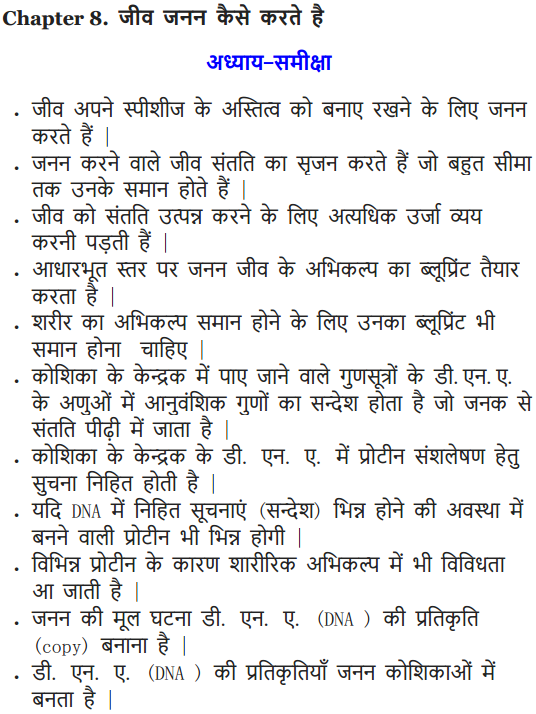
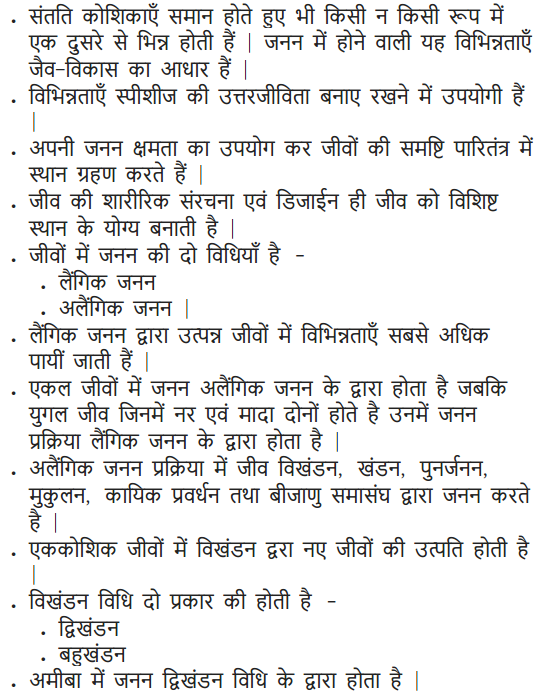
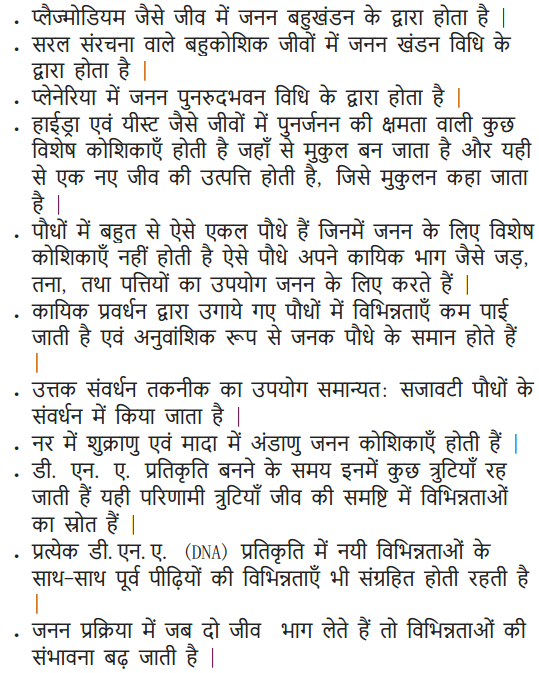
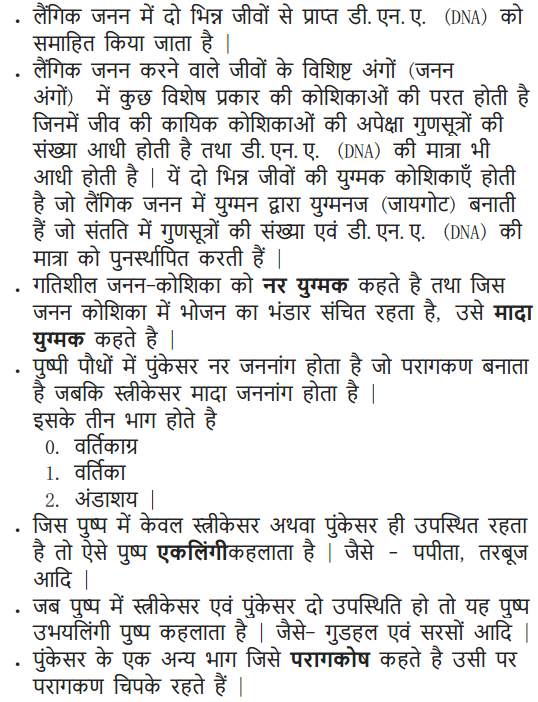
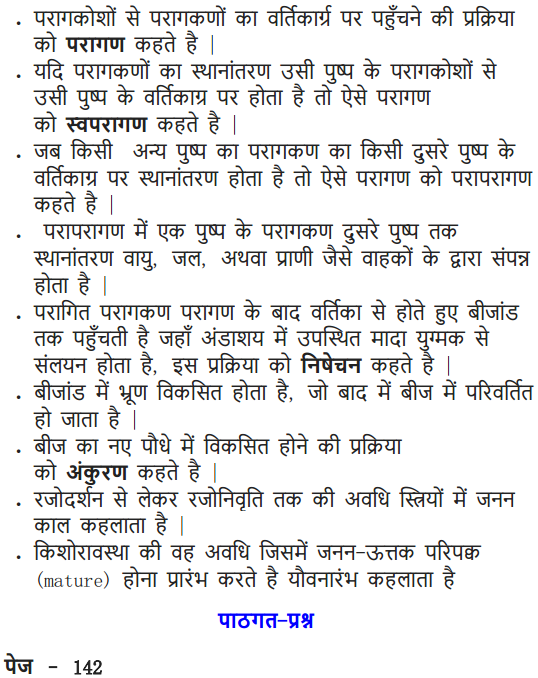
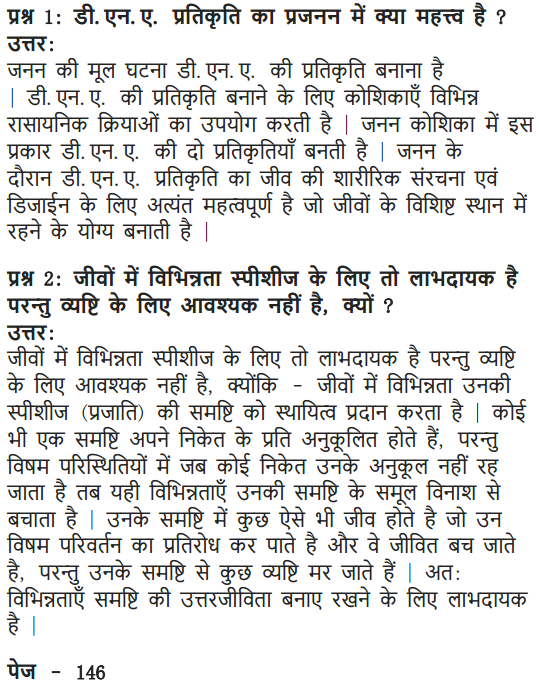
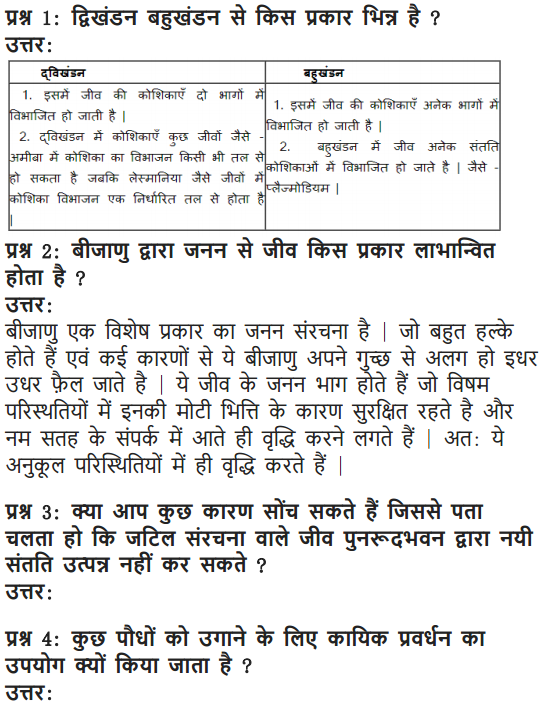
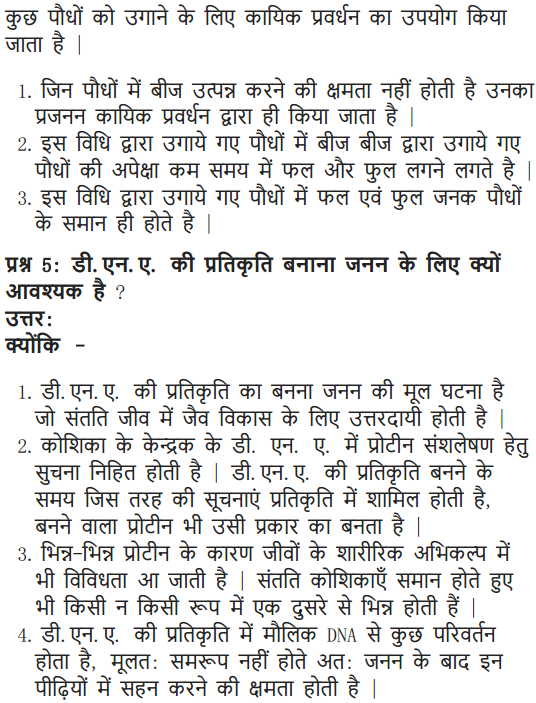
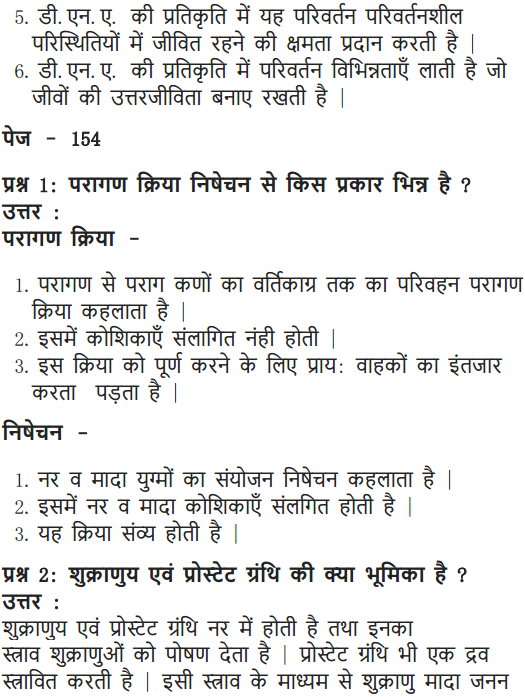
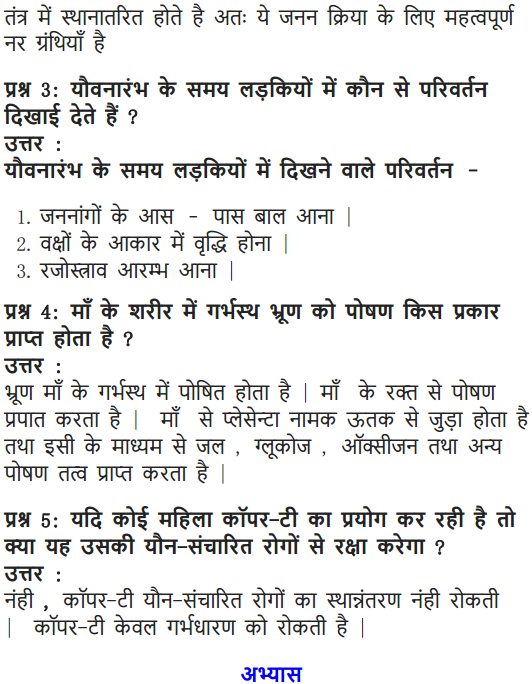
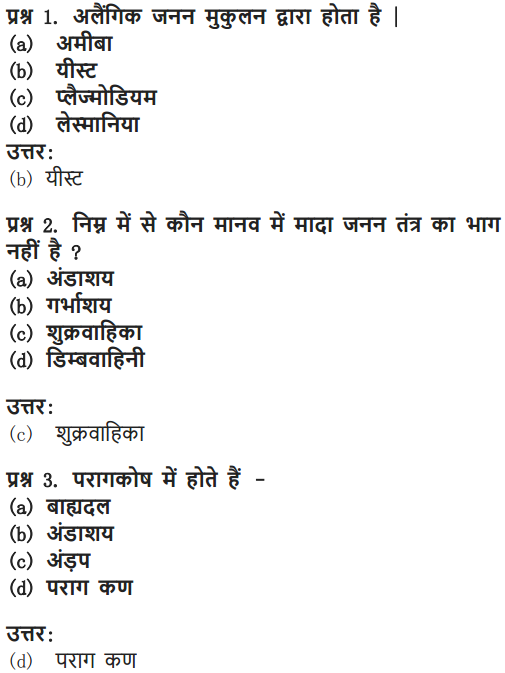
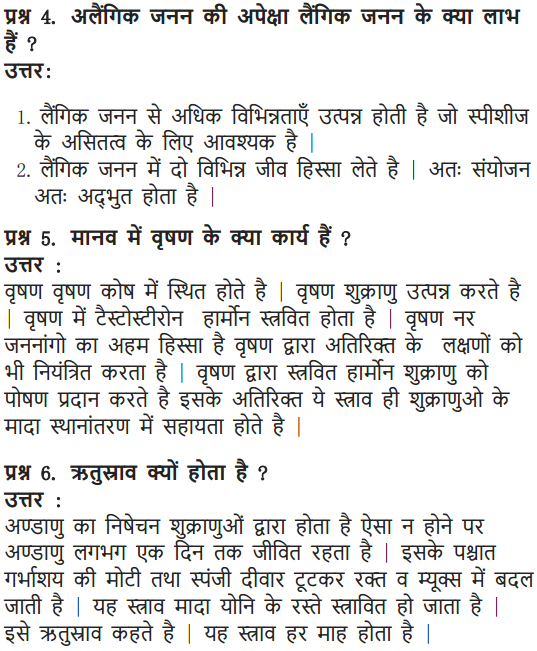
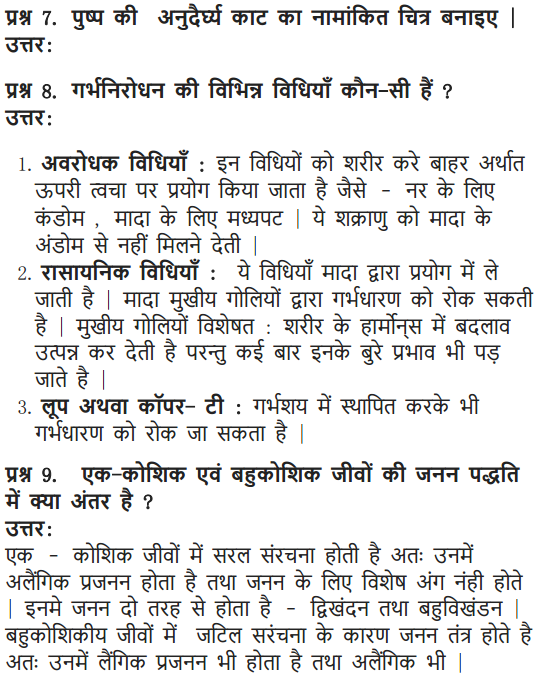
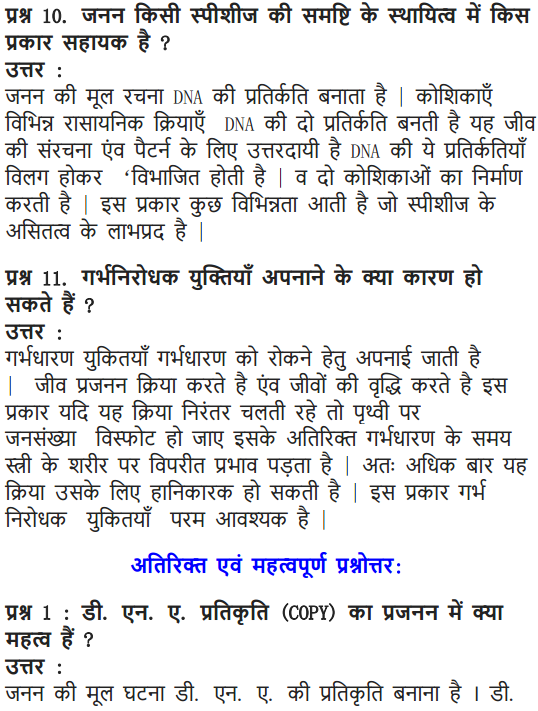
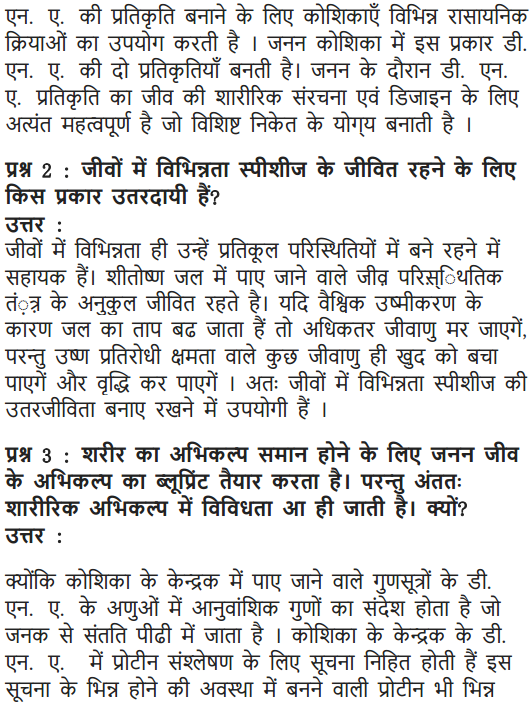
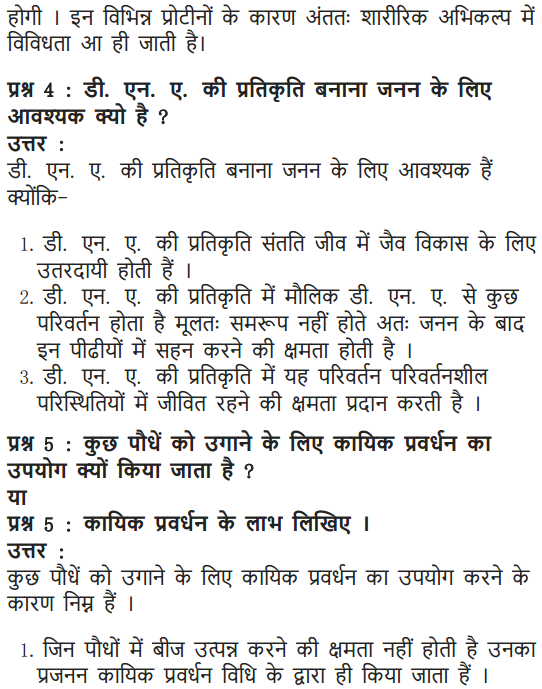
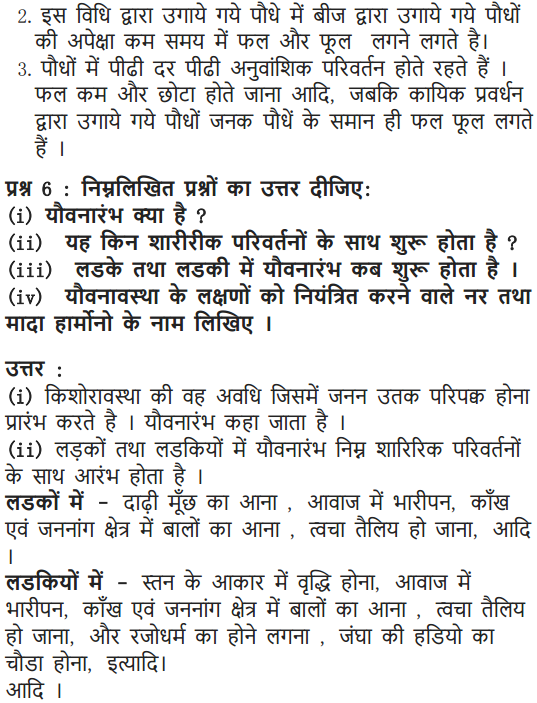
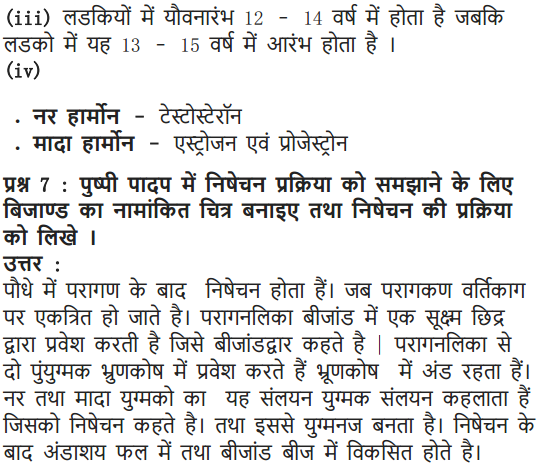
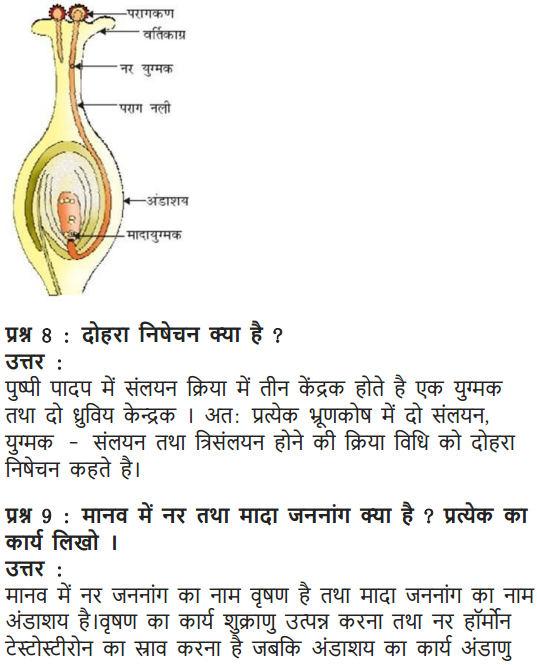
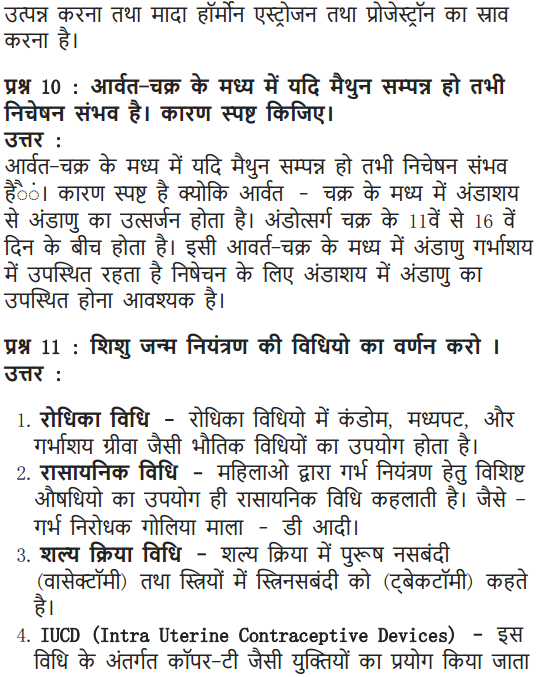
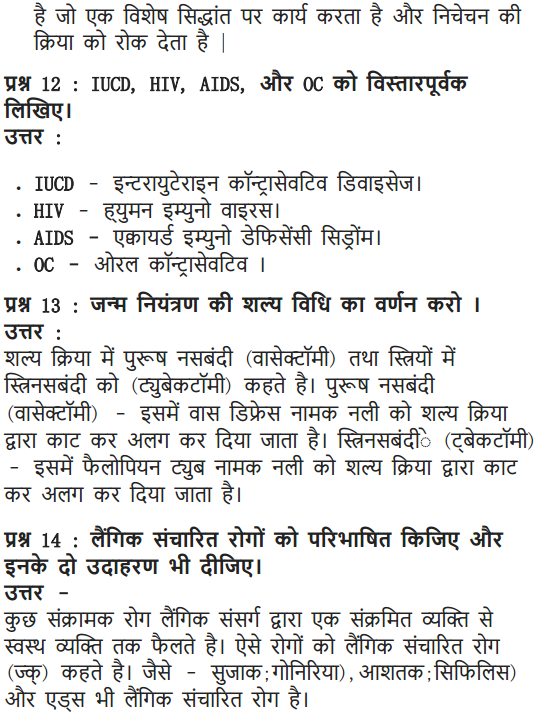
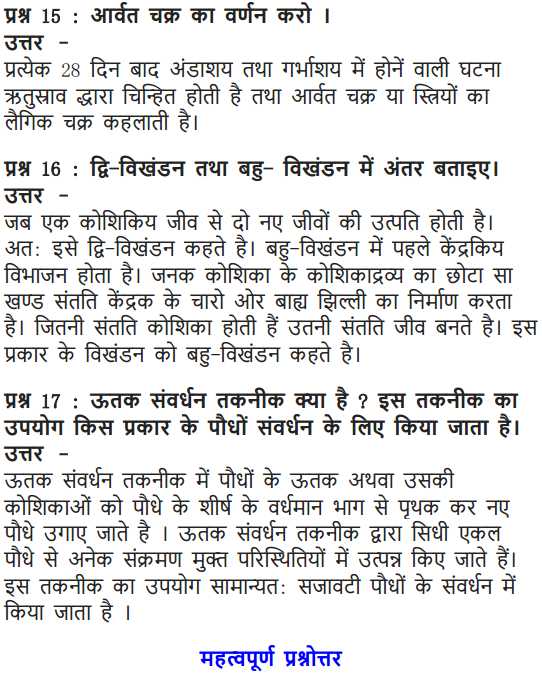
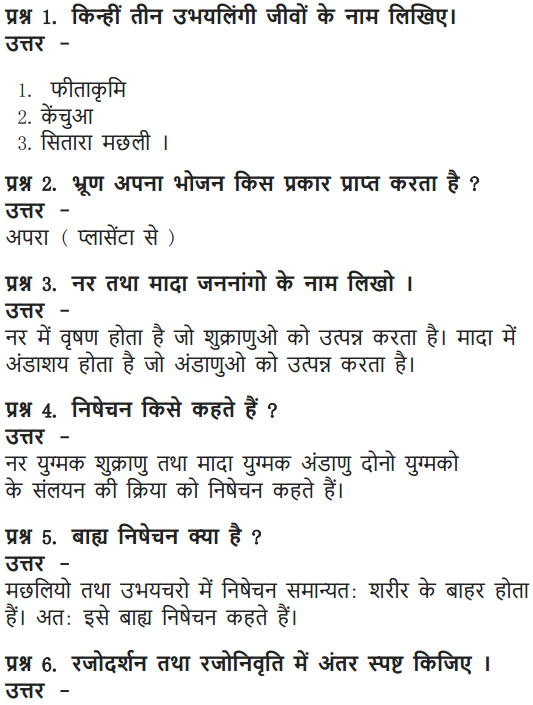
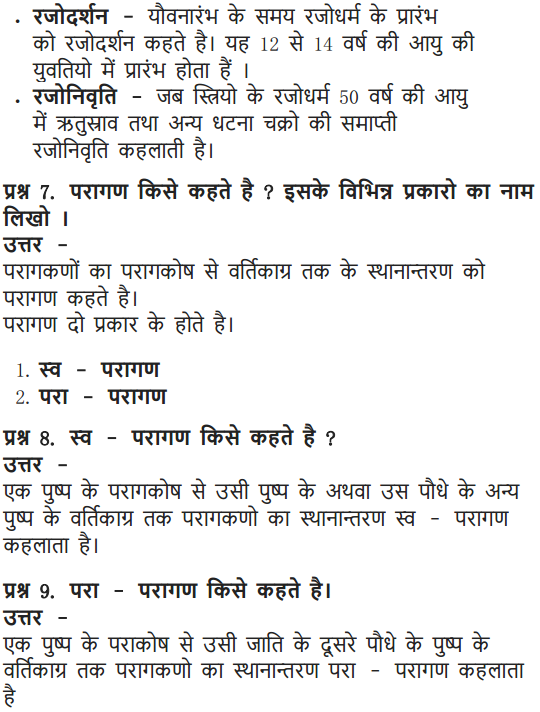
Class 10 Science How Do Organisms Reproduce Mind Map
- Reproduction is a biological process in which an organism gives rise to young ones similar to themselves.
- Basic event in reproduction is the creation of a DN A copy.
- Cells use chemical reactions to build two copies of the DNA in a reproducing cell.
- In addition, DNA copying is accompanied by the creation of an additional cellular apparatus.
- Then each DNA copy is separated with its own cellular apparatus.
- Effectively, a cell divides to give rise to two cells.
Asexual Reproduction
When offspring is produced by single parent with or without the involvement of gamete formation.
Fragmentation
- Parent organism breaks into smaller fragments upon maturation, each fragment grows into a new individual.
- It is shown by multi-cellular organisms with simple body organization for e.g. Spirogyra
Fission
- Organisms divide mitotically into two halves, each behaves like independent individual. It is termed as binary fission and is mostly shown by bacteria and protozoa.
- Binary fission can take place in any plane as observed in Amoeba, or it can occur in a definite orientation for e.g. Leishmania (causes kala-azar), Euglena (longitudinal), Paramecium (transverse) etc.
- In few organisms parent cell divides into many daughter cells simultaneously which is termed as multiple fission. It is observed in Plasmodium.
Budding
- Formation of daughter organism takes place from a small projection called as bud. For e.g. Hydra, Yeast etc
- Organisms such as Hydra use regenerative cells for reproduction in the process of budding.
- Repeated cell division at one specific site leads to the formation of an outgrowth called as bud.
- These buds develop into tiny individuals and detach form parent body once they become fully mature.
- Detached organism acts as an independent organism.
Regeneration
- It is an ability of simple organisms to re-grow their lost body parts.
- In asexual reproduction, this ability is used by many organisms to give rise to new individual from their body parts. That is, if the individual is somehow’ cut or broken up into many pieces, many of these pieces grow into separate individuals.
- For e.g. Hydra and Planaria
- It is carried out by specialized cells which proliferate & differentiate to make various cell types tissues.
- These changes take place in an organized sequence referred to as development.
- However, regeneration is not the same as reproduction, since most organisms would not normally depend on being cut up to be able to reproduce.
Spore Formation
- An individual divides into no. of small spores, each spore giving rise to new individual.
- Spores are covered by thick walls that protect them until they come into contact with moist surface or suitable environment and can begin to grow. E.g. Spore formation in Rhizopus
Vegetative Propagation
- It refers to the formation of new plants from parts of parent plants such as root, stem, leave etc. These parts are termed as vegetative units or vegetative propagules. For e.g. buds produced in the notches along the leaf margin of Bryophyllum fall on the soil and develop into new plants
-
Advantages of vegetative propagation:
- Vegetative propagation is used in methods such as layering, cutting, grafting to grow many plants like sugarcane, roses, or grapes for agricultural purposes.
- Plants raised by vegetative propagation can bear flowers and fruits earlier than those produced from seeds.
- It makes it possible to propagate plants that have lost the capacity to produce seeds such as banana, orange, rose and jasmine.
- Plants produced are genetically similar enough to the parent plant to have all its characteristics.
Sexual Reproduction
It involves the formation and fusion of the gametes. It leads to formation of variations in individuals. Variations form the basis of evolution of the species and ensure the survival of the species.
Reproduction in Human Beings
Puberty:
The period during which adolescents reach sexual maturity and become capable of reproduction.
- Changes in girls during puberty: breast size begins to increase, darkening of skin of nipples, & girls begin to menstruate.
- Changes in boy during puberty: hair growth on face, voices begin to crack & occasional erection & enlargement of penis
- Changes common to both boys & girls: hair growth in various parts such as armpits, genital area, thin hairs on arms & legs and skin may become oily.
Female Reproductive System
- It consists of a pair of ovaries, pair of oviduct (fallopian tube), uterus, cervix, & vagina.
- One egg is produced every month by one of the ovaries after reaching the age of puberty. The egg is carried from the ovary to the womb through a thin oviduct or fallopian tube.
- Uterus serves as womb and is richly supplied with blood vessels to nurture the developing embryo.
- Vagina serves as the site of entry of sperm during sexual intercourse.
Male Reproductive System
- It consists of a pair of testes located outside the body in a pouch called scrotum. It helps in maintaining lower temperature which favors the perm formation. Testes are responsible for synthesizing sperms and testosterone.
- Sperms are tiny bodies consists of mainly genetic material and a tail that helps them to move towards the female germ-cell.
- Sperms are then delivered through vas deferens which unites with urethra to form a common passage for sperm and urine.
- Accessory glands like seminal vesicles, prostate, and bulbourethral add their secretion to sperm. It makes the sperm fluid in nature that not only eases the transportation of sperm but also provide the nutrition to it.
Reproductive Health
- Sexually transmitted diseases include bacterial infections (gonorrhea, syphilis etc) & viral infections (warts, AIDS etc).
-
Contraception refers to the act of preventing the unwanted pregnancies. Contraceptive methods may fall in following categories:
- Mechanical barrier: e.g. condom, diaphragms. They also prevent STDs.
- Oral contraceptives: they change hormonal balance, inhibits ovulation & thus fertilization e.g. saheli, iPill, etc.
- Intra uterine device: plastic or metal devices placed in the uterus for e.g. loop, copper-T etc.
- Surgical methods such as vasectomy & tubectomey.
Events of Reproduction
- The sperms after entering the vaginal passage travel upwards and reach the oviduct where they may fertilize the egg.
- Post-fertilization, the zygote gets implanted in the lining of the uterus, and starts dividing.
- Special tissue called placenta is developed to provide nutrition to the developing embryo as well as for removing waste from it.
- The development of a child takes up approx, nine months.
- The child is born as a result of rhythmic contractions of the muscles in the uterus.
Menstruation
Menstrual cycle is a cyclic event that places roughly every month in females after puberty. Unfertilized egg lives for 1 day after which it degenerates. Consequently, uterus lining slowly breaks & comes out through the vagina as blood & mucus. This discharge is known as menstruation which lasts for about 2-8 days.
Sexual Reproduction in Flowering Plants
•
Stamens and carpels are the reproductive parts of a flower which contain the germ-cells. Stamen is the male reproductive part and it produces pollen grains. Carpel is the female reproductive part made up of three parts: ovary, style and stigma.
•
The ovary contains ovules and each ovule has an egg cell.
•
The flower may be unisexual i.e. contains either stamens or carpels e.g. papaya, watermelon or bisexual i.e. contains both stamens and carpels e.g. Hibiscus, mustard.
•
Transfer of pollen grains (shed from the anther) to the stigma of a pistil is termed pollination. Two types: self-pollination and cross pollination. Pollinating agents are air, water, insects, & animals.
•
Compatible pollen grain germinates on stigma to produce pollen tube. Pollen tube grows through tissues of stigma, style & reaches ovary.
•
Fertilization results in the formation of zygote which develops into an embryo.
•
The ovule develops a tough coat and is gradually converted into a seed. The ovary grows rapidly and ripens to form a fruit.
•
The petals, sepals, stamens, style and stigma may shrivel and fall off.
•
The seed develops into a seedling under appropriate conditions which is known as germination.
We hope this detailed article on NCERT Solutions For Class 10 Science Chapter 8 How Do Organisms Reproduce? helps you. If you have any query regarding the how do organisms reproduce class 10 notes NCERT solutions, drop it in the comment section below and we will get back to you.
NCERT Solutions for Class 10 Science All Chapters
- Chapter 1 Chemical Reactions and Equations
- Chapter 2 Acids, Bases and Salts
- Chapter 3 Metals and Non-metals
- Chapter 4 Carbon and Its Compounds
- Chapter 5 Periodic Classification of Elements
- Chapter 6 Life Processes
- Chapter 7 Control and Coordination
- Chapter 8 How do Organisms Reproduce?
- Chapter 9 Heredity and Evolution
- Chapter 10 Light Reflection and Refraction
- Chapter 11 Human Eye and Colourful World
- Chapter 12 Electricity
- Chapter 13 Magnetic Effects of Electric Current
- Chapter 14 Sources of Energy
- Chapter 15 Our Environment
- Chapter 16 Management of Natural Resources